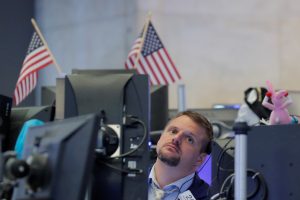
By Megan Davies
NEW YORK (Reuters) – Economists and investors are watching for signs they hope can predict when the wheels will come off a near-record U.S. economic expansion and equities bull market.
Some are already worried about a flattening Treasuries yield curve and slowing housing market, even as other economic vital signs remain healthy.
U.S. economic growth will probably slow gradually over the next two years and the threat of a trade war has made a recession more likely, a recent Reuters poll predicted.
A majority of bond market experts in a separate poll now predict a yield curve inversion in the next one to two years, a red flag for those who believe short-term yields rising above longer-term yields means an imminent recession.
“Almost every client meeting includes questions about where the economy and markets sit in the cycle,” JPMorgan head of cross-asset fundamental strategy John Normand wrote in a recent research note.
The U.S. economy is a year away from surpassing the record 120-month 1991-2001 expansion, according to data from the National Bureau of Economic Research.
The stock market bull run is also nearing a record. Bull markets are typically measured retroactively, but U.S. equities could hit their longest bull run in history on Aug. 22, according to S&P.
The U.S. economy is “late cycle” but a recession is not imminent, a number of economists and strategists say.
“We believe that the U.S. economic expansion is entering the final third of its cycle,” wrote analysts at Wells Fargo Investment Institute, although they said various indicators do not suggest a recession this year.
1. THE YIELD CURVE
The U.S. yield curve plots Treasury securities with maturities ranging from 4 weeks to 30 years. The spread between two-year and 10-year notes is typically used when discussing yield curve inversion. The gap between long- and short-dated yields turning negative has been a reliable predictor of recessions. The yield curve has been flattening in recent months.
2. SHORT-TERM BILLS
An alternative yield curve measures the difference in the current interest rate on 3-month Treasury bills and expectations for the yields 18 months from now. Federal Reserve officials have found this measure is a stronger predictor of recession in the coming year. The measure currently suggests little recession risk.
3. UNEMPLOYMENT
The unemployment rate and initial jobless claims ticked higher just ahead or in the early days of the last two recessions before rising sharply. Unemployment hit an 18-year low in May of 3.8 percent but nudged up to 4 percent in June.
4. OUTPUT GAP
The output gap between the economy’s actual and potential gross domestic product has fallen ahead of the last two recessions.
“Currently we estimate that the output gap is nearly closed, but not yet in the ‘overheating’ territory,” wrote Kathy Bostjancic, head of U.S. investor services at Oxford Economics, in May.

FILE PHOTO: A trader works in a work space on the floor of the New York Stock Exchange (NYSE) in New York, U.S., July 24, 2018. REUTERS/Brendan McDermid/File Photo
5. STOCK MARKETS
Falling equity markets can signal a recession is looming or has already started to take hold. Markets turned down before the 2001 recession and tumbled at the start of the 2008 recession.
On a 12-month rolling basis, the market has turned down ahead of the last two recessions. The 12-month rolling average percent move is now below its 2018 peak but higher than recent lows.
6. BOOM-BUST BAROMETER
The Boom-Bust Barometer devised by Ed Yardeni at Yardeni Research measures spot prices of industrials inputs like copper, steel and lead scrap, and divides that by initial unemployment claims. The measure fell before or during the last two recessions and is below its 2018 peak.
7. HOUSING MARKET
Housing starts and building permits have fallen ahead of some recent recessions. Housing starts and permits fell to the lowest level since September 2017 in June.
8. EARNINGS GROWTH
S&P 500 earnings growth dipped ahead of the last recession. Earnings growth is expected to slow slightly this year and more next year, but remain in the high single digits or low double digits in 2019.
9. SOUTH KOREA EXPORTS
South Korean exports fell during the last recession and before the previous recession.
Those exports, which include cars, phones, steel and other products, tend to be a leading indicator, said Bank of America Merrill Lynch chief investment strategist Michael Hartnett. Exports from China are also increasingly important as weak Asian exports tend to coincide with weak global and U.S. growth.
South Korea’s export growth came to a halt in June. China, the world’s largest exporter, reported exports accelerated in June.
The United States and China have fired the first shots in what could become a protracted trade war. The United States and South Korea agreed in March to revise a trade pact.
10. HIGH-YIELD SPREADS
The gap between high-yield and government bond yields rose ahead of the 2007-2009 recession and then widened dramatically. Credit spreads typically widen when perceived risk of default rises. Spreads have fallen slightly this year.
11. INVESTMENT-GRADE YIELDS
Risk premiums on investment-grade corporate bonds over comparable Treasuries have topped 2 percent during or just before six of the seven U.S. recessions since 1970. Spreads on Baa-rated corporate bonds rose to 2 percent this month based on Moody’s Investors Services data, according to Leuthold Group’s chief investment strategist Jim Paulsen.
12. MISERY INDEX
The so-called Misery Index adds together the unemployment rate and the inflation rate. It typically rises during recessions and sometimes prior to downturns. It has nudged higher in 2018 but is still relatively low.
(Additional reporting by Richard Leong, Dan Burns, Jenn Ablan and Howard Schneider; Editing by Meredith Mazzilli)

